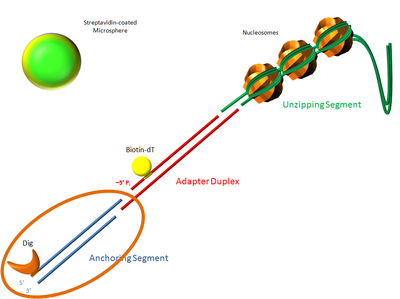User:Anthony Salvagno/Notebook/Research/2009/11/02/Redoing Unzipping: Anchor Digestion
Preaction Info
Elution Buffer is 10mM Tris pH 8.5, but can also be done with water. For water elution, pH must be within 7-8.5 for maximum efficiency. The danger with water is that DNA may degrade faster than with Tris.
For gel extraction, the most that a column can handle is 400mg. That is good to know.
PCR Cleanup and Digestion
I cleanup nicely, using Qiaquick PCR Purification kit. After cleanup I nanodropped my DNA just to make sure I eluted properly and here is what I got (in each of 2 columns):
- 256.7ng/ul in 50ul --> 12.8ug
- 291.3ng/ul in 50ul --> 14.5ug
I don't know how it could be more 10ug per column but I'll just take it to mean I have a lot. I'm going to assume I have about 10ug of DNA per column because that is what I was expecting based on my gel intensities. (Steve Koch 01:22, 3 November 2009 (EST): I think it's possible to get more--they probably are conservative when specing their product. It's also possible the nanodrop is a bit off. I agree with your plan of just assuming 10 ug for now...unless I read more and decide we care more about it's exactness.)
Next I setup a digestion.
NEB Buffer #3 is 100mM NaCl, 50mM Tris-HCl, 10mM MgCl2, 1mM DTT, pH 7.9 @ 25C. (Steve Koch 01:24, 3 November 2009 (EST): I was confused earlier and now see that "buffer #" is labeled as "3". I think you should get rid of that row and just say "10x NEB Buffer #3" in the following row.)
Gel Extraction
Qiaquick Gel Extraction kit. I used autoclave tape to make one giant well out of the comb. This turned out to be a little too big, but I just cut out all the agarose without any DNA when I made slices. Because each column can only process 400mg of gel, I had to use 4 columns. I eluted in 30ul of EB (Tris) per column. If all goes well by the end of this step I will have this today:
 (Steve Koch 01:30, 3 November 2009 (EST): Did you take a picture of the gel? If so, definitely upload it. If not, definitely I'd like pictures in the future. As one example of why, I'm a little unclear about what "extra" gel you got rid of. Also, Andy is struggling with the same issue now, but we need still need a way of referencing standard materials protocols. E.g., what kind of gel? What kind of agarose? How did you run the gel, and for how long? A lot of this stuff is the same every time, but we need good ways of making it obvious what you did to the reader of this page only. We'll keep getting better at this over the next few months.)
(Steve Koch 01:30, 3 November 2009 (EST): Did you take a picture of the gel? If so, definitely upload it. If not, definitely I'd like pictures in the future. As one example of why, I'm a little unclear about what "extra" gel you got rid of. Also, Andy is struggling with the same issue now, but we need still need a way of referencing standard materials protocols. E.g., what kind of gel? What kind of agarose? How did you run the gel, and for how long? A lot of this stuff is the same every time, but we need good ways of making it obvious what you did to the reader of this page only. We'll keep getting better at this over the next few months.)
Results
According to my nanodrop I got the following numbers:
- 152.0ng/ul
- 121.3ng/ul
- 119.3ng/ul
- 154.0ng/ul
- 138.2ng/ul - I combined all the tubes into one and took a final reading.
If the digestion worked well, I would have 188.5nM of Anchor DNA in about 100ul. I got about a 60% yield on the gel extraction which I am happy for. This is a happy day for me. (Steve Koch 01:25, 3 November 2009 (EST): Awesome! I really liked this page, and am super happy with your yields. That's a lot of DNA. Great work!)
Side Note
Andy just brought this to my attention: Betaine is useful in PCR. I should look into this for future reactions.
Also Koch mentioned something about a ligation test. I can't remember what that is right now. But I should begin planning for that. (Steve Koch 01:27, 3 November 2009 (EST): Not sure if we need to do it or not. The idea was to test whether this piece was good by ligating it to something complementary and big enough to see on a gel. E.g. from gel extracted BstXI-digested pRL574. It may be more work than it's worth at this point, though.)